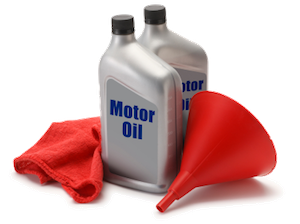home | e-mail | terms of use
oilspecifications.org
Lubrication glossary
- Additive
- A compound mixed to the base oil in order to modify its properties or performance.
- Base Oil
- Usually refined crude oil fraction or selected synthetic base stock. Additives are mixed to them during lubricant manufacturing.
- Total Base Number (TBN)
- The amount of acid required to neutralize the lubricant’s basicity expressed in KOH equivalent.
- Detergent Additive
- An additive mixed to fuel and lubricants in order to keep the engine clean. The most used detergent additives in motor oils are metallic soaps that have enough base reserves to neutralize the acids formed during engine operation.
- Pour Point
- Indicates the fluidity of the oil or fuel on low temperature. It’s the lowest temperature on which the fluid still flows.
- Dispersant Additive
- An additive, which keeps the solid contaminants in colloid suspension, thus prevents the oil sludge and varnish buildup on the engine parts. This additive is usually non metallic (ashless) and it’s used together with detergent additives.
- DPF (Diesel Particulate Filter)
- The DPF is a physical filter that reduces the solid particle content of the exhaust gases.
- Ring Sticking
- Ring sticking occurs when the piston ring sticks into the groove due to excess contamination.
- EGR (Exhaust Gas Recirculation)
- A system designed to reduce the NOx emission. It recirculates the exhaust gas back into the intake manifold thus diluting the fuel/air mixture and reducing the temperature and NOx formation.
- Pre-ignition
- Pre-ignition is the combustion of the fuel/air mixture that occurs in internal combustions engines before the spark plug fires. Typical reasons are the hot fuel or the lubricant buildup in the combustion chamber. It reduces engine power and it can damage the engine.
- EP Additive
- Lubricant additive that prevents the seizing of the sliding surfaces under extreme pressure conditions.
- Refining
- A series of processes through which the crude oil is converted into a petroleum product. Such processes include: thermal cracking, catalytic cracking, polymerization, alkylation, reforming, hydrocracking, hydroforming, hydrogenation, hydrogen treating, solvent extraction, dewaxing, de-oiling, acid treating, clay filtration and deasphalting.
- Anti foam additive
- An additive to reduce the foaming of petroleum products. Can be silicone to destroy the surface bubbles or polymer to reduce the count of small internal bubbles.
- Ash
- Metallic residue formed due to the high temperature in the combustion chamber or on other engine parts.
- Hydrofinishing
- Hydrogen treatment of crude oil in order to saturate the molecules and increase stability.
- HTHS (High Temperature High Shear) Viscosity
- A measure of a fluid’s resistance to flow under conditions resembling highly-loaded journal bearings in fired internal combustion engines, typically 1 million per second @ 150 °C.
- Catalytic Converters
- Oxidizing catalytic converters remove hydrocarbons from the exhaust gas, while reducing catalytic converters reduce the NOx emissions. Both types contain noble metal (platinum, palladium or rhodium), which can be poisoned by lead or phosphorous present in fuel or lubricants.
- Lubrication
- The reduction of friction and wear using a friction-reducing layer. This layer can be liquid, solid or plastic.
- Kinematic Viscosity
- The fluid’s resistance to flow when affected by gravity. Usually measured on 40 °C or 100 °C.
- Varnish
- Thin, insoluble non-wipeable layer on the internal parts of the engine. It can cause the sticking and breakdown of internal moving engine parts.
- Anti-Wear Additive
- An additive that creates a thin layer with good adhesive properties in order to prevent metal-to-metal contact at high-load spots.
- Corrosion Inhibitor
- An additive that protects the lubricated metal parts from the chemical attacks caused by water or other contaminants.
- Flash Point
- Minimum temperature at which a fluid will support instantaneous combustion, but before it will burn continuously. The flash point is an important indicator when determining the fire and explosion hazard of a petroleum product.
- Oil sludge
- Thick, dark residue with mayonnaise-like consistency, which builds up on the non-moving inner parts of the engine. Insoluble contaminants in the oil accelerates its buildup.
- Oxidation
- Occurs when the petroleum product reacts with oxygen. The process is accelerated by heat, light, metallic catalysts, water, acids or the presence of solid contaminants.
- Oxidation stability
- A petroleum product’s resistance against oxidation. Affects product life both in storage and in use.
- Total Acid Number
- The required amount of KOH to partially or fully neutralize the petroleum product’s acidity.
- Friction
- The resistance that occurs when one object is moved on another object. The friction depends on the smoothness of the sliding surfaces and on the force used to press them on one another.
- Synthetic Lubricant
- Lubricant made of specifically composed chemically reacting substances that has pre-determined properties and characteristics.
- Pumpability
- A low-temperature property of the oil, which determines to what extent is the oil capable to flow to the pump on low temperatures.
- Multigrade Oil
- A motor or gear oil that meets the requirements of more than one SAE viscosity grade and thus it can be used in a wider temperature range.
- Tribology
- Science branch dealing with friction, wear and lubrication.
- Viscosity
- A fluid’s resistance to flow.
- Viscosity index
- The relationship between a fluid’s viscosity and temperature. Fluids with a higher viscosity index change their viscosity to a lesser degree due to the change of temperature.
- Viscosity modifier
- Lubricant additive, usually a polymer that provides beneficial rheological properties to lubricating oils, such as reducing the tendency of an oil’s viscosity to change with temperature.


